Module 6: Let’s Search the Irish Land Records
In this module we continue our Irish record search strategy by examining relevant Irish Land records and correlating the information we uncover with previous discoveries for Patrick Dolphin and his family. We encourage you to replicate the searches we share in our case-study so you can use these approaches later for your own Irish ancestry research.
Table of Contents
Introduction.
In the last module:
- We searched the Irish RC Church Record sets for evidence of the origins of Patrick Dolphin and his family. We had a number of “discovery questions” in mind to help us focus.
- We started by using Johngrenham.com to see if we were likely to find a baptismal record for Patrick Dolphin in Leitrim parish in 1855 and then went to the RC church records at the National Library of Ireland to look at the source records available online on microfiche.
- We used a paid service called Rootsireland.ie to speed up our search of the RC church records. Using the service, we found a number of records related to Patrick Dolphin of Ballydavid and his family. We captured this information in the “Discovery Questions and Answers Worksheet” shown above.
- We also looked at some other useful search approaches using Rootsireland before summarising our findings.
- We decided that the final step in our record search strategy was to search available Irish land records (Griffith’s Valuation of the mid 1800s and Tithe Applotment Books of the early 1800s) to see if we can uncover new information on the Dolphin family and correlate those findings with our other discoveries so far in this course.
In this module we will:
- Search the Irish Land records for evidence of the Dolphin family in Ballydavid, County Galway in the early to mid 1800s.
- Primarily use the Griffith’s Valuation records of the mid 1800s – but also look at the Tithe Applotment Books of the 1830s.
- See if the specific dwelling (or land) where Patrick Dolphin was born still exists today – maybe we can line it up for a future visit!
- Record what we discover and then decide on how to progress with our research.
- Finally, we will encourage you to replicate our findings using the same approach and the same Irish record sets.
Before searching the Irish Land Records – Let’s Review the information we have gathered so far.
Let’s remind ourselves of the key information we have already gathered for Patrick Dolphin and family. The information is summarised in the following two worksheets:
- The “Discovery Question and Answer Worksheet” we completed at the end of the last module.
- The “Land Division Research Worksheet” we compiled for Ballydavid townland.
As before, we will use this information through this module – updating the “Discovery Question and Answer Worksheet” at the end with all new information discovered. Here is each worksheet in turn:
Our “Discovery questions” and answers so far.
Our initial discovery questions are shown below in black in column 1. All additional and gathered information is shown in red:
| Discovery Question | Answer/Notes |
|---|---|
| Where was Patrick Dolphin born in Galway? | ? |
| Is Ballydavid in County Galway? | Yes. Ballydavid is in: Civil Parish: Kilcooly SRD: Loughrea RD: Bullaun DED:Kilmeen Near Market Town: Loughrea RC Church Parish: Leitrim and Kilcooly RC Church Dioceses: Clonfert. Source: All sources shown in “Land Division Research Worksheet” |
| Was there a Dolphin family living there in 1855? | ? |
| What was Patrick Dolphin’s first wife’s name? | Looks like she was Mary Costillo. Father was Michael Costillo and she was born around 1857. Source: Irish Civil Marriage Record. |
| Where was she from? | Loughrea, County Galway. Source: Irish Civil Marriage Record. |
| When and where did they marry? | Married in the RC chapel of Loughrea, County Galway. January 18, 1881. Source: Irish Civil Marriage Record. |
| Where and when was Michael Dolphin junior born? | Michael Dolphin was born in Loughrea, County Galway on May 3rd, 1881. It looks as if he was born less than four months after his parents marriage. Source: Irish Civil Birth Record. |
| When did Patrick’s first wife die? | We searched the Civil Death records for the period 1881 to 1895 but did not discover any relevant records. |
| Other discoveries: | Found Dolphin family living in Ballydavid in 1901 census – head of family (Martin Dolphin) appears to be the brother of our Patrick Dolphin as they were both living in Ballydavid when married and share the same father’s name. |
The Land Division Research Worksheet we compiled for Ballydavid townland.
The Land Division-related information for Ballydavid townland is in the “Land Division Research Worksheet” we previously compiled – see below. I have highlighted the relevant land division types in red that will be important as we search the Irish Land records:
| Land Division Type | Name | Where land division type is used. | Notes |
|---|---|---|---|
| Townland | Ballydavid | All civil, land, census and some church records. | Information we started with |
| County | Galway | All civil, land, census and church records. | Information we started with |
| Civil Parish | Kilcooly | All civil and land records. | Obtained from Johngrenham.com |
| RC Church Parish | Leitrim and Kilcooly | All church records – Baptisms, Marriages and Burials/Deaths. | Obtained from SWilson.info |
| RC Church Dioceses | Clonfert | All church records – Baptisms, Marriages and Burials/Deaths. | Obtained from SWilson.info |
| Superintendent Registrar’s District (SRD). Same boundaries as earlier Poor Law union (PLU). | Loughrea | Civil vital records – Births, Marriages and Deaths. | Obtained from Johngrenham.com |
| Registrar’s District (RD) Subdivision of SRDs. | Bullaun | Civil vital records – Births, Marriages and Deaths. | Obtained from Johngrenham.com |
| District Electoral Division (DED – sometimes just ED). | Kilmeen | Census records. | Obtained from townlands.ie |
| Local Market Town | Loughrea | None – but useful to get your bearings for a townland. | Obtained from SWilson.info |
Let’s Review Our Irish Record Search strategy.
Here is the record search strategy we have followed:
- We started with the 1901 Irish census records. We searched for evidence of Dolphin families in a place called Ballydavid in County Galway – starting with the Ballydavid in the Civil Parish of Kilcooly.
- If we found evidence that Patrick Dolphin’s family/relatives are in the 1901 census in the area, we will then figure out if there is any tie between those Dolphins and our Patrick Dolphin by working our way back in time through the Irish Civil, church and land record sets to help answer our discovery questions.
- If we found no evidence, then we need to adopt a different record search strategy. However, the benefit of the approach I outline above is that it can be carried out fairly quickly and then either used or discarded.
Outcome so far: We discovered relevant information for Patrick Dolphin and his family from both the census, civil and RC Church records. The next step is to try and answer the following discovery question through the rest of this module:
Was there a Dolphin family living in Ballydavid in 1855 (the year of Patrick Dolphin’s birth)? Bonus: Can we locate any dwelling/land discovered on a modern map? Is it accessible for a visit at some point in the future?
Let’s now proceed with a search of the Irish land records for evidence of a Dolphin family living in Ballydavid about 1855 – and maybe pick up some related interesting information along the way and connect our new discoveries with the other information we have uncovered so far on Patrick Dolphin and his family.
Browsing and Searching the Irish Land Records.
As I have stated before, the purpose of this course is to familiarise you with the Irish record sets – using the Dolphin case-study to help us focus. We will now examine the Irish land records of the 1800s to see if there was a Dolphin family living in Ballydavid in 1855 (when Patrick Dolphin was born) and see if we can locate the specific plot of land (or dwelling) on both a historical map and a modern map (to line up a visit in the future).
Browsing and searching Griffith’s Valuation Land Records.
We start the Griffith’s Valuation records. This set of Irish land records is available to browse for free here: https://www.askaboutireland.ie/griffith-valuation/
The following explanation of the Griffith’s Valuation records can be found on that site:
Griffith’s Valuation is the name widely given to the Primary Valuation of Ireland, a property tax survey carried out in the mid-nineteenth century under the supervision of Sir Richard Griffith. The survey involved the detailed valuation of every taxable piece of agricultural or built property on the island of Ireland and was published county-by-county between the years 1847 and 1864.
The Griffith’s Valuation of Ireland recorded the county, townland (or street), the name of each occupier, the landlord name , the type of landholding and number of acres as well as the value of the buildings and land in each holding. This information is useful in our Irish family history research given that Irish census records only exist in fragments before 1901. As a result, the Griffith’s Valuation records act as a census substitute – providing us with information on holdings in a particular townland (or street) at an exact point in time in the 1850s including the name of the tenant for each holding. Historical maps are also included that show the location of most properties within a townland.
The initial Griffith’s Valuation was a massive undertaking and was updated every subsequent 2-5 years in what is called the “Primary Valuation of Tenements” (more usually called “the land revision books”). We will not be covering these “land revision books” in this course as much of the information is unavailable online.
Now, let’s examine Griffith’s Valuation of Ireland and see how useful it may be for our Dolphin family case-study:
Here is the first screen that you will see when you go to https://www.askaboutireland.ie/griffith-valuation/ :
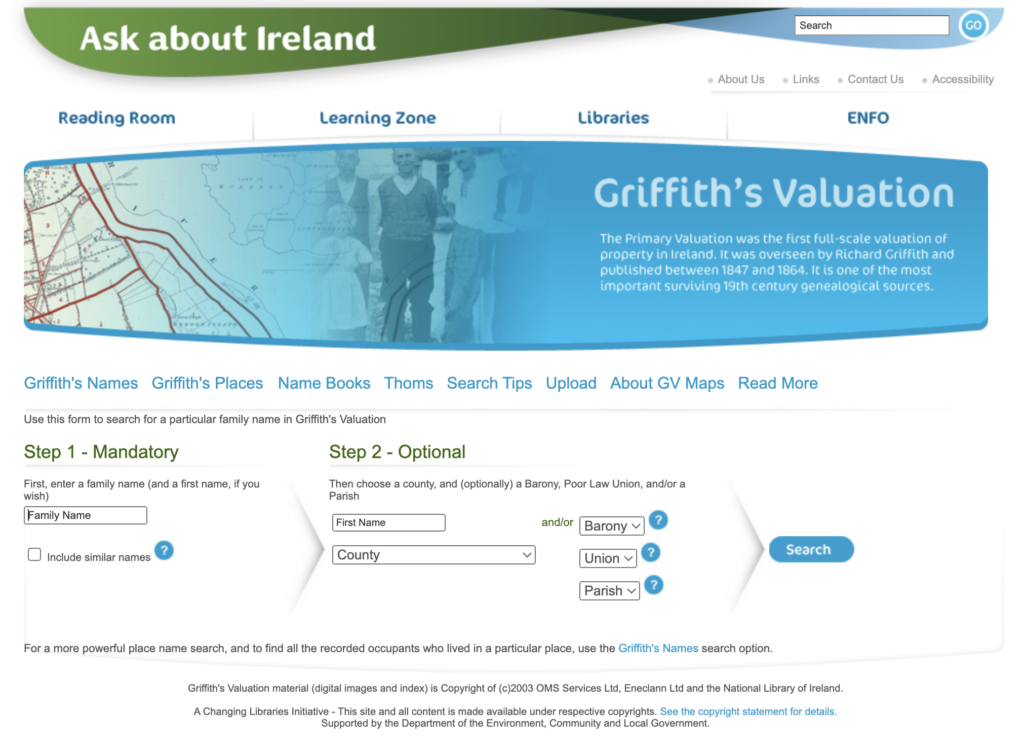
Because we know we are looking for the occupants of a townland called Ballydavid in the Civil Parish of Kilccoly in County Galway (from our Land Division Research Worksheet), we enter the information outlined in red below for an initial search. Note: Because this is a form of civil record, we are only offered the option of the Civil parish name of Kilcooly rather than the RC church parish name of “Leitrim”:
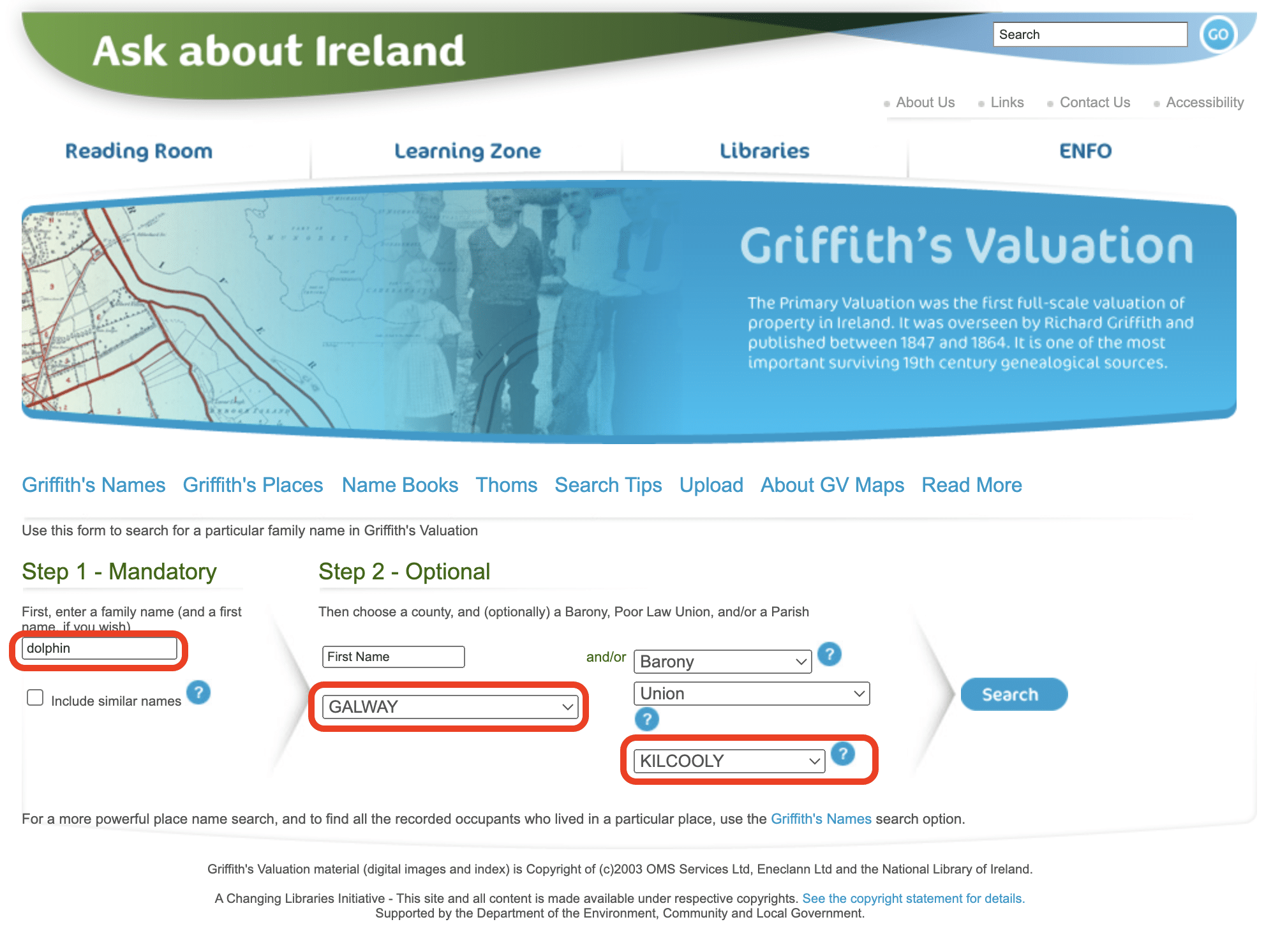
When we click the “search” button the following three entries are returned. We can see there were two Michael Dolphins and one Hannah Dolphin listed as tenants in Ballydavid townland, Kilcooly Civil Parish, County Galway:

Let’s go through the important pieces of information in turn:
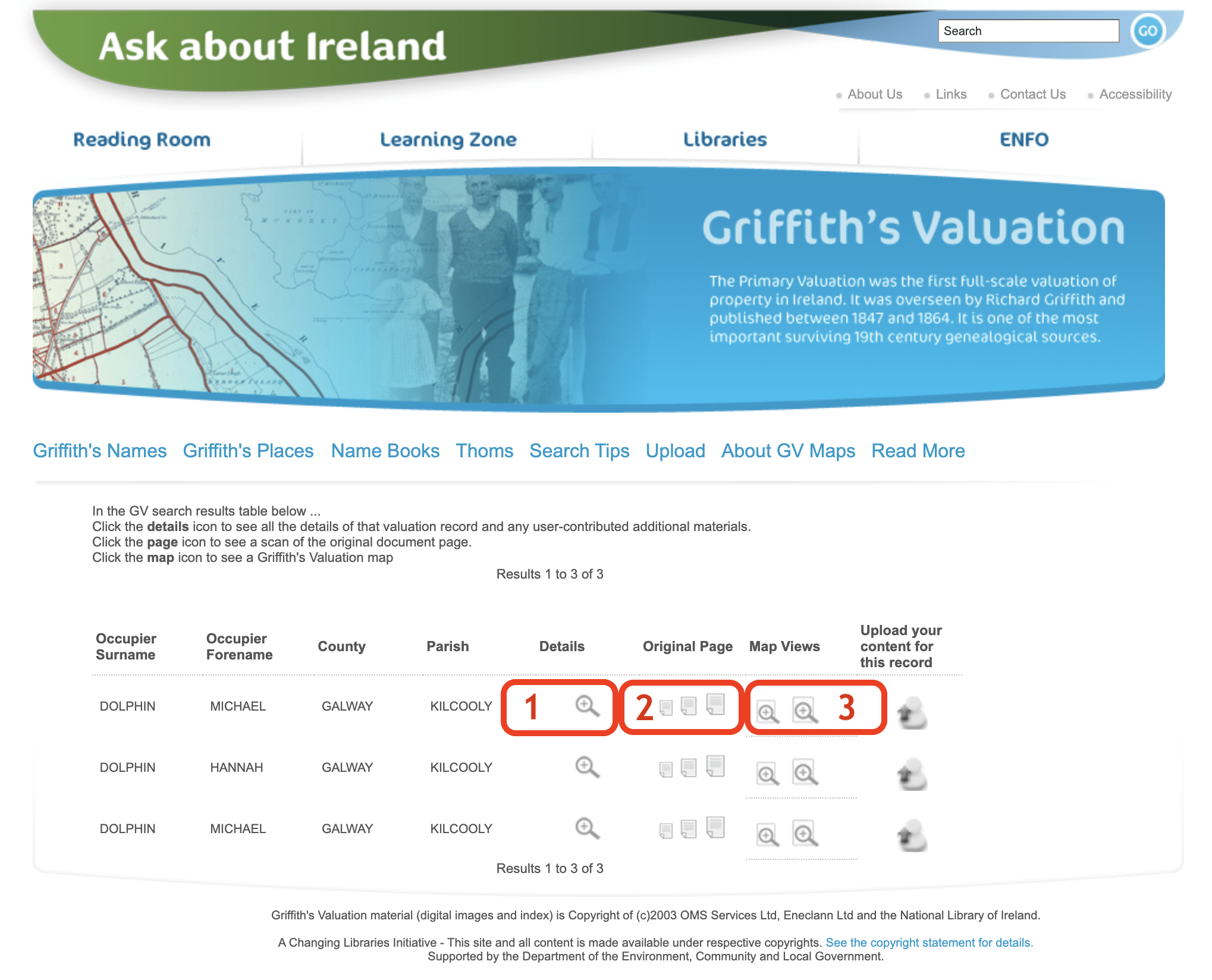
I have outlined three clickable options in red above – “Details”, “Original Page” and “Map Views”. We will now go through each of these in detail:
1. “Details”: Click on the magnifying glass icon outlined in 1 above and the following transcription of the Griffith’s Valuation information for Michael Dolphin in Ballydavid is provided:
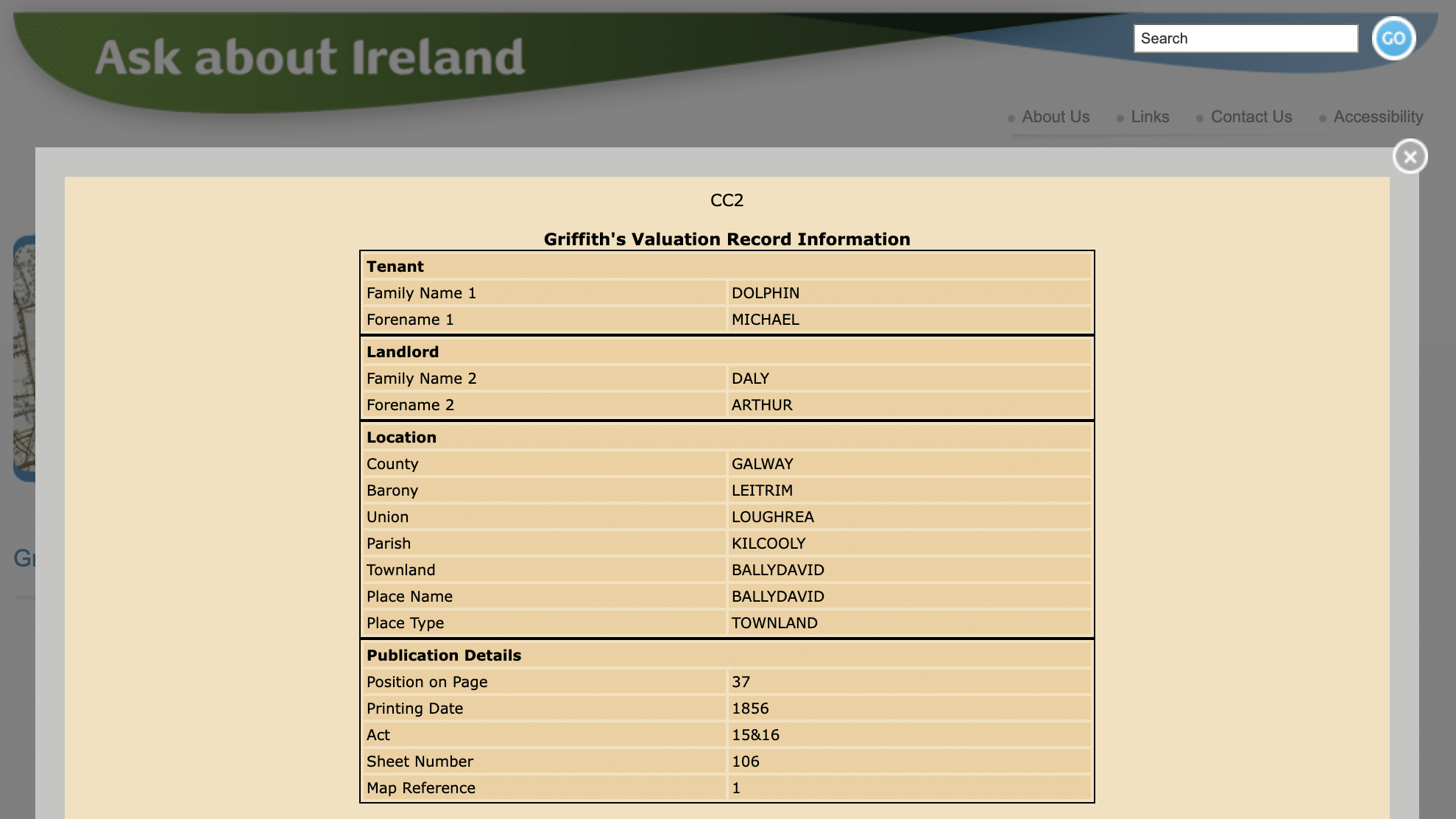
This transcribed data is taken from the original record and map information. We can see that this record notes a Michael Dolphin as being a tenant in Ballydavid townland, Kilcooly parish about 1856. Remember that Patrick Dolphin was born in 1855 to Michael and Margaret Dolphin. This Griffith’s Valuation suggests that a Michael Dolphin did live in Ballydavid at that time. Very useful information to carry forward in our research.
If you repeat the above process for the other two entries provided, you will find that:
- Hannah Dolphin was also a tenant in Ballydavid at the time (different landholding to Michael Dolphin). Who was Hannah Dolphin? My best guess at this time is that she is the widow of a Dolphin man who was a previous listed tenant of this land. Is there a family connection between the two Dolphins listed in Ballydavid? Probably, but we would need to examine the civil and church records further to determine just what that might be.
- The second entry lists a Michael Dolphin who also lives in Kilcooly Civil Parish – but in the townland of Carrowroe, not Ballydavid. It is possible that this is the same Michael Dolphin as the one found in Ballydavid – tenants are often listed multiple times in Griffith’s Valuation if they have tenancy on unconnected holdings (often in adjacent townlands).
Next, let’s look a little closer at the Michael Dolphin who was listed as the first entry.
2. “Original Page”: Click on the magnifying glass icon outlined in 2 below:

The following copy of the original Griffith’s Valuation record is returned:
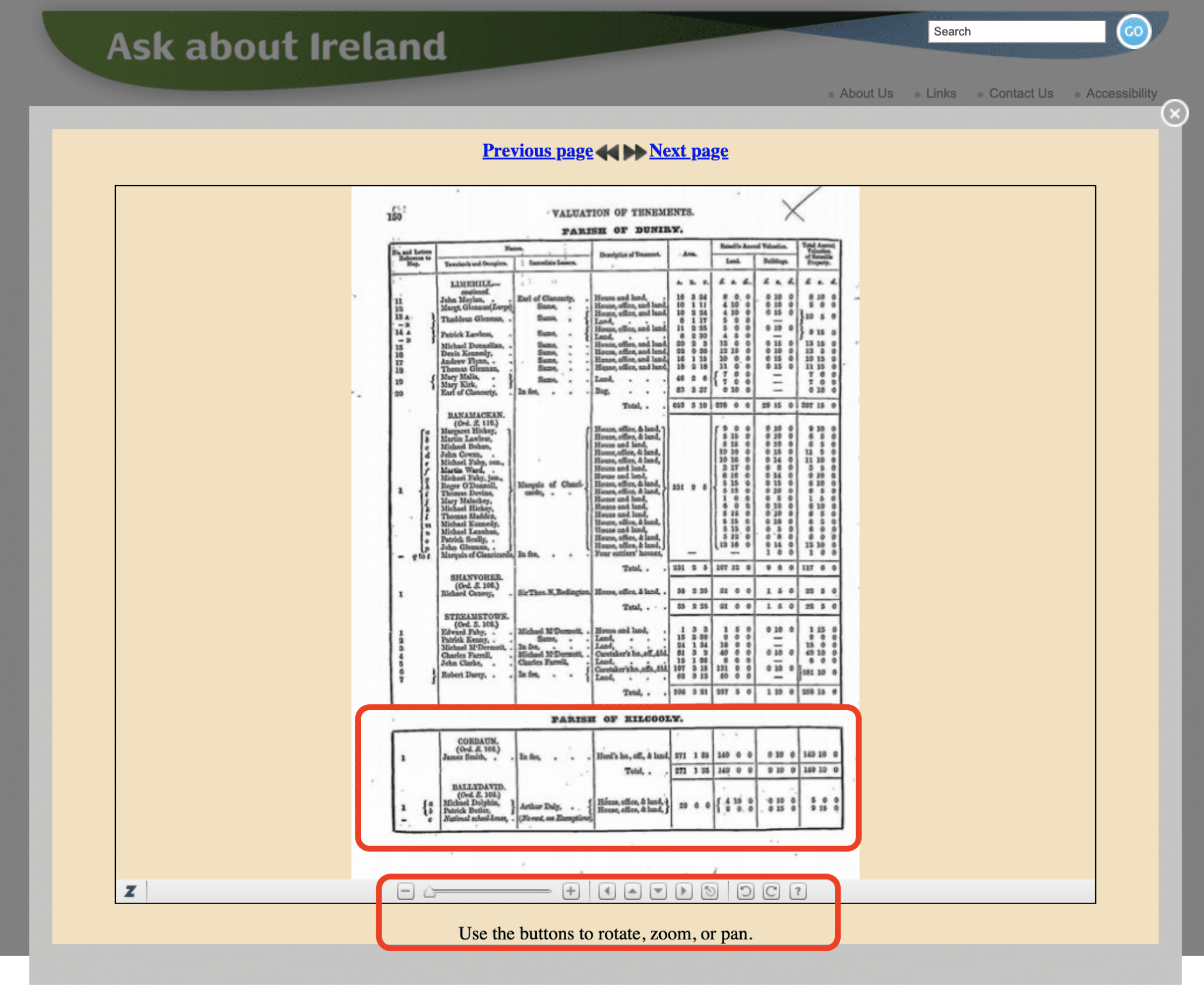
We are interested in the “Parish of Kilcooly” which I have outlined in red towards the end of the page above. Zoom in using the buttons at the end of the page and you will see the following – the start of the listing of tenant information for the townland of Ballydavid:
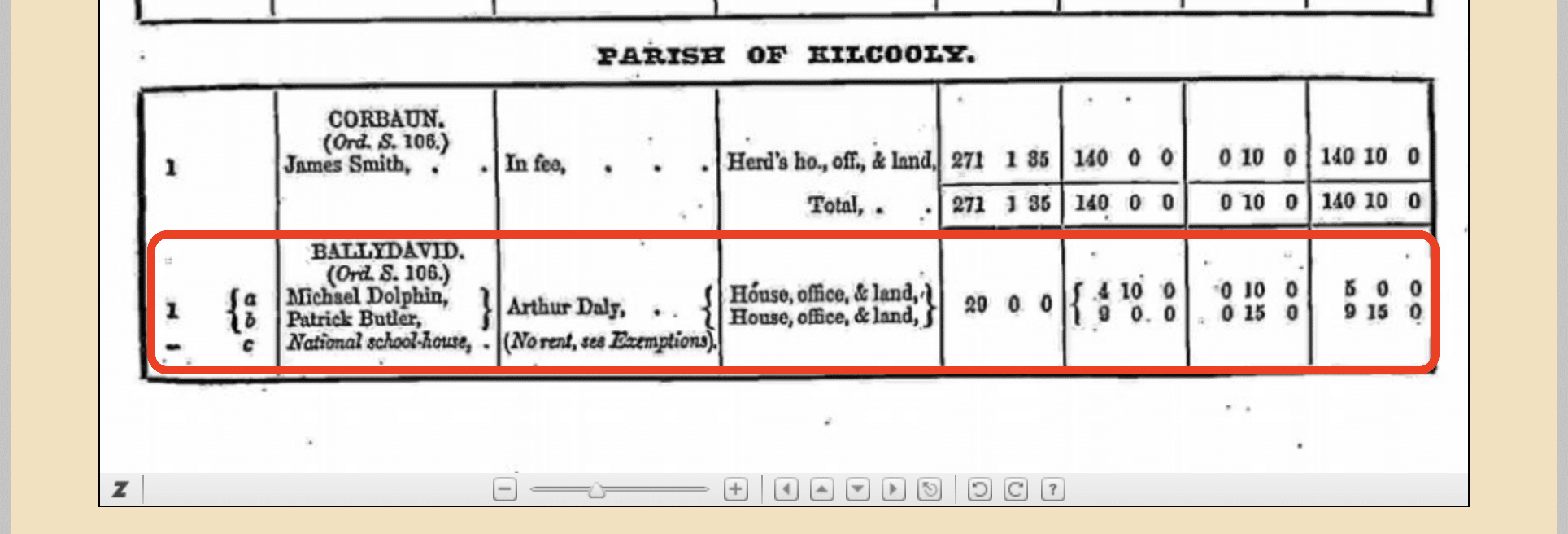
Next, advance to the next page to see the rest of the listed tenants for Ballydavid townland below:
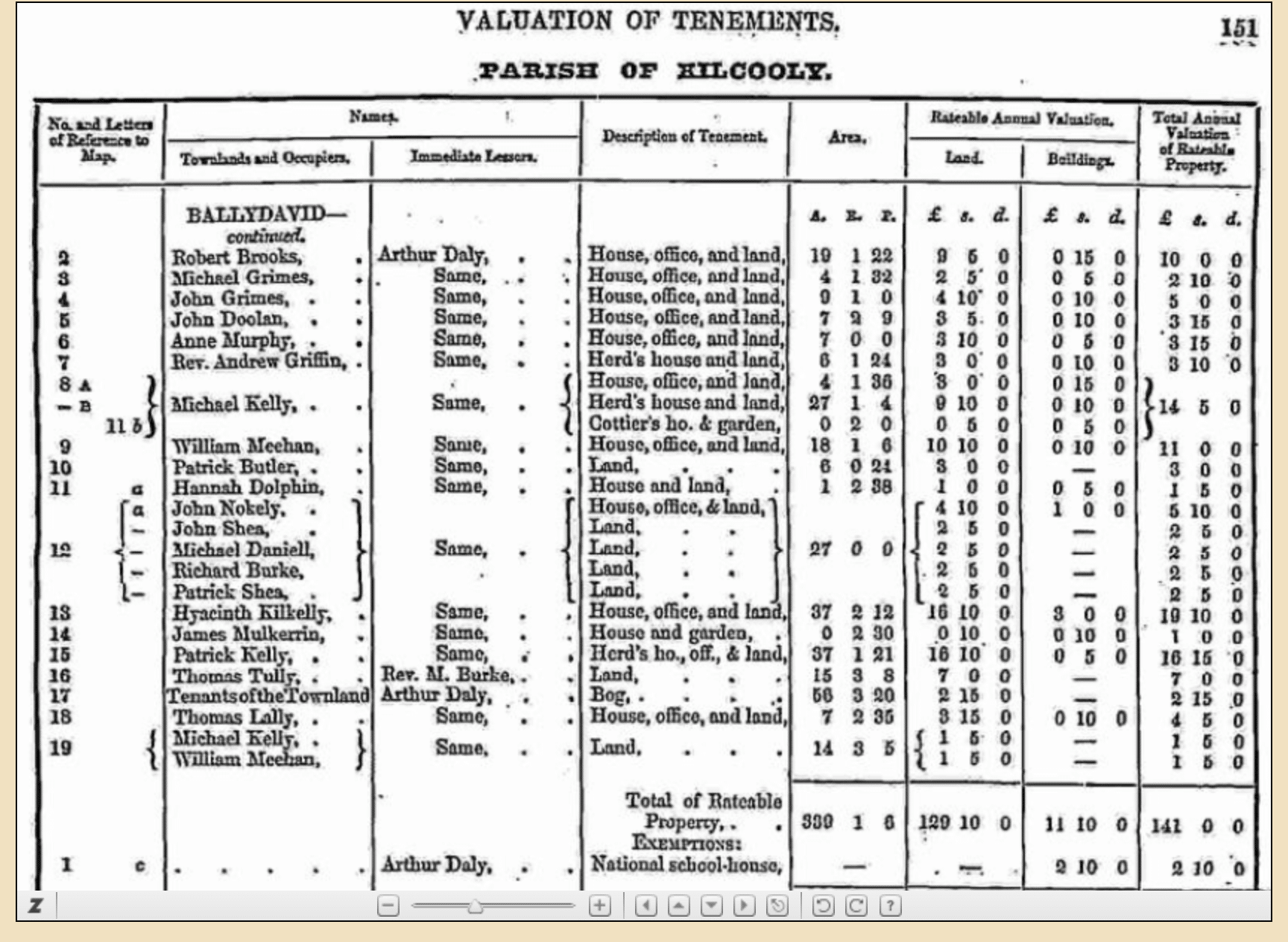
Let’s break the information provided down further:
- Start with entry 1 (so numbered in column 1) for Ballydavid. This shows a “Michael Dolphin” as tenant of subdivision “a”. Because there is a house listed in this subdivision, it possibly the main residence of the Ballydavid Michael Dolphin.
- We can also see that there is a Patrick Butler listed in 1b. Remember that the parents of our Patrick Dolphin in New Hampshire was most likely a Michael Dolphin and a Margaret Butler? I wonder if this is the brother of that Margaret Butler?
- Michael Dolphin and Patrick Butler jointly occupy a 20 acre plot of land. Both have a house and “office” on the property, but the plot acreage assigned to each is not specified. However, we can see that Michael’s land valuation is half of that of Patrick’s, suggesting that the 20 acres is split one-third to Michael and two-thirds to Patrick. Additionally, Patrick’s house value is two-thirds of Patrick’s – indicating that Michael’s property (including outbuildings) may be smaller of or poorer condition than Patrick’s.
- We also see that there is a schoolhouse occupying entry 1 in 1856. These school houses often still stand today and is most likely the place where Patrick Dolphin and his siblings attended school.
- Looking at the “Immediate Lessor” column we see that Arthur Daly was the landlord for almost all the tenancies in Ballydavid. These landlords sometimes lived locally – sometimes were absentee. However, other landlords of the area were often the occupant of the large house in the area. I find that a useful resource to cross-check with this information is the Samuel Lewis topographical dictionary of Ireland which was compiled in 1837 (you can find it here: https://www.libraryireland.com/topog/placeindex.php ). It provides a lot of useful information on areas in Ireland in the mid 1800s. In this case I looked up Kilcooly Civil parish here: https://www.libraryireland.com/topog/K/Kilcooly-Leitrim-Galway.php which mentions one of the “Gentlemen” (landlords) of Kilcooly Civil parish being an “A. Gore Daly, Esq. of Ballydavid”.
- On the second page of Griffith’s Valuation listing shown – go to entry 11 you will see Hannah Dolphin residing in a house and land. However, if you look at the acreage this is just over an acre with a house on it. My guess is that she kept the tenancy of part of the land on the death of her husband and that the original holding may have been subdivided (entry 10-Patrick Butler- nephew?). I would also note that the name Hannah (or Johannah) was often the anglicised form of Honoria or Honora. So, although you see her listed as Hannah in these records, you may find her listed as Honoria or Honor in other records e.g. RC Church records.
- In entry 17 you will notice a “bog” (poor wet soil) which was used by the collective tenants of the townland. This was often the tradition in the west of Ireland where poor land was used for collective grazing.
- A final interesting thing to observe is on entry 8. There you see a Michael Kelly listed as the tenant – there is a house listed (probably lived in by Michael Kelly) but also a “herds” house and a “cottier” house. These latter houses were used by transient farm labourers (sometimes only living in an area for 11 months at a time) that made up a substantial amount of the population of rural areas previous to the famine of the 1840s. Their transience often meant that they were not listed in many of the Irish land records of the time – or you may notice something like a different place of residence as each of their children is born.
So, what can we learn from the above examination of the Griffith’s Valuation? It provides evidence that there was a Dolphin family living in Ballydavid in 1855 – and that they were most likely the parents of Patrick Dolphin (Michael Dolphin and Margaret Butler).
Next, we look at the “Map View” option in Griffith’s Valuation. We’ll see if we can discover more on the holding of Michael Dolphin in Ballydavid townland – and maybe discover if there is much to see in that location today.
3. “Map Views” in Griffith’s Valuation Records.
Let’s continue with a look at the mapping option in Griffith’s Valuation for Ballydavid. We are interested in the area marked “3” below:

Click on the larger of the two “Map views” icons (see 3 above), and the following historical map of the general area in County Galway will appear on your screen. Somewhere in the centre of the circle we will find the holding of Michael Dolphin in the townland of Ballydavid:

Use the “+” zoom button at the bottom right of the screen to zoom in for a closer look. You will eventually see the following – and be able to read the name of the civil parish of Kilcooly in the centre of the circle – and the names of each townlands in Kilcooly Civil Parish are outlined in thick red line (not my lines – these are on the original maps) below:

We now zoom in a little more to see the townland of Ballydavid – located to the north of the Kilcooly name. Each area/holding within Ballydavid is outlined in a thin red line. We are looking for holding “1” in Ballydavid (the entry for which we saw Michael Dolphin listed earlier) . You can see it to the bottom right of Ballydavid:

Let’s zoom in further into this holding labelled 1. You can see a road towards the bottom of the plot – and a smaller road (lane?) going into a group of buildings (each building is a small black rectangle). However, there is no house “a” shown in the map of holding 1 (remember, Michael Dolphin is house marked “a” in area 1 of Ballydavid townland).

Sometimes you can go to a later revision of a map to try and discover the correct house labels. How? See the “Map version” option at the right of the screen below? Click on the up arrow to step through different map versions (often displayed in black and white”) that may provide further information on exact house location etc.

For example, stepping through to Map Version 4 of 7 – we clearly see buildings marked “a”, “b” and “c” within holding 1 (I have outlined in red below):

The building labelled “a” probably marks the spot where the family of Michael Dolphin lived in the mid 1800s.
I wonder what stands there today? Let’s find out:
- Click on the “Satellite” option at the top left of the screen.
- Next, see the “Modern Map/Historical Map” slider at the top right of your screen? Slide that towards “Modern Map” to discover what is in the area today:
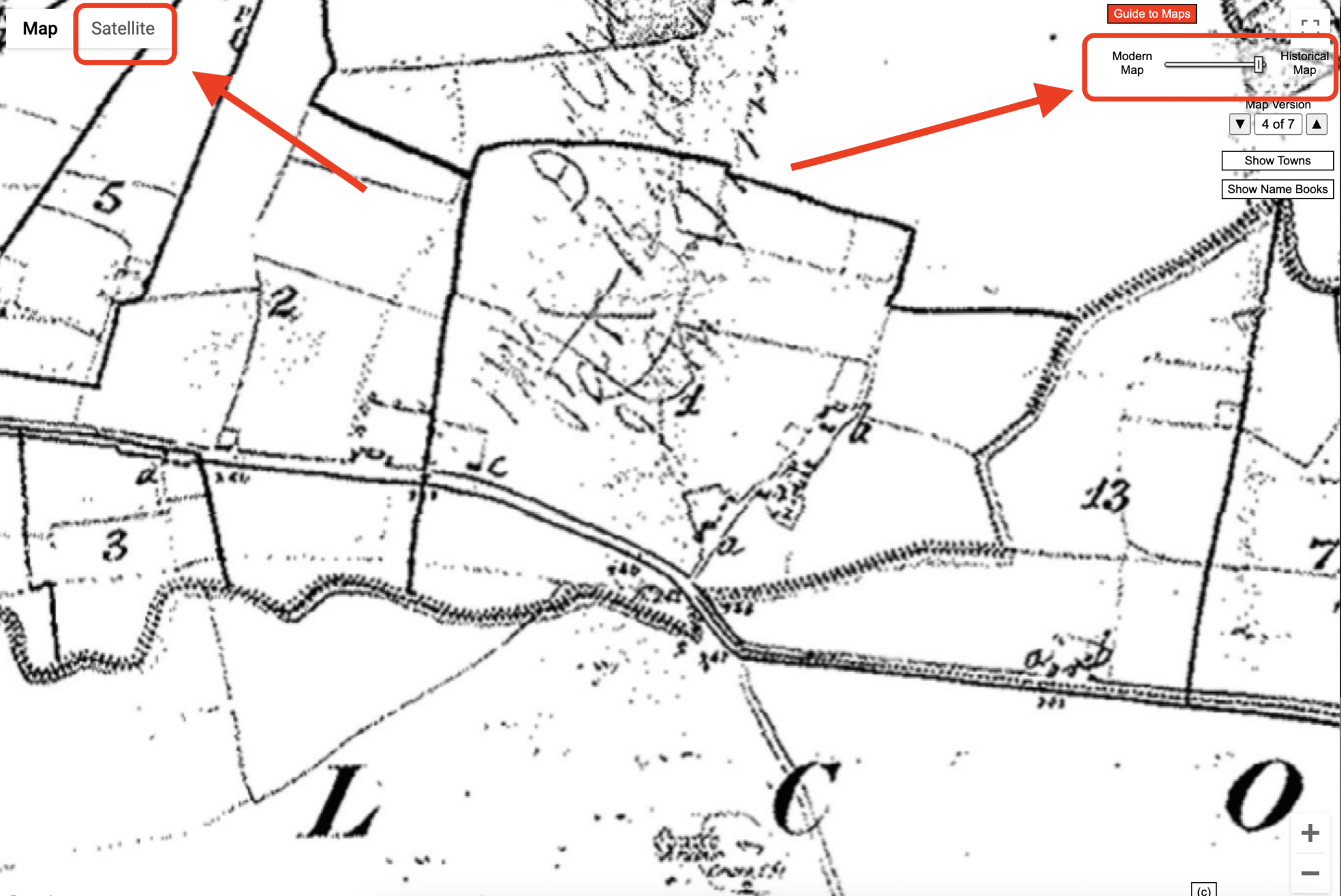
As we move the slider to half way between “modern map” and “historical map” the historical map becomes transparent and we see the modern map at the same time. We can use this overlay to inspect just how accurate the location of historical features are compared with the modern features (in this case they are out a small bit – have a look at the modern main road vs the old road). I have outlined the location of building “a” – where Michael Dolphin lived:

Move the slider fully over to “Modern Map” and we see the locations I believe the buildings a, b and c are located today:

Looking back at the Griffith’s Valuation listing for Ballydavid – entry “1”:

We can see that it lists Michael Dolphin , Patrick Butler AND a school house. On the modern map let’s examine each building in turn:
- Building “a”: Some form of house still stands today where Michael Dolphin’s house stood in the 1850s. Note that many houses from the 19th century were more basic than we see today. In many cases a more modern house was build near the old house – the old house often turned into storage or housing for animals.
- Building “b”: There appears to be a thicket of trees off a laneway – there may be the ruins of buildings (including building “b”) in that area today.
- Building “c”: It looks like the National School House still stands in this location today (probably renovated and extended).
It looks like we have discovered buildings linked to the Dolphin family in the 1850s – and may be accessible today – all made possible by using various Griffith’s Valuation tools.
This is always an exciting step to locate the likely place where an ancestor lived in Ireland!
Next? Well, because I live in Ireland (and have a thick skin!), I might turn up at the door-step of neighbours and explain what I have discovered – and then ask permission to take photos of old buildings etc. In doing so, I often hear from the occupier (sometimes a cousin of the person we are researching) of a local person who can fill me in on which Dolphin descendants are still living in the area and where. This is really where the rubber hits the road!
In the next section we will see if we can discover any more on the presence of the Dolphin family of Ballydavid townland by going back a little further to the 1830s and looking at the “Tithe Applotment Books”.
Browsing and searching the Tithe Applotment Books.
Finally, to make sure you become familiar with all the major online Irish record sets – we go back in time to the 1820/30s and examine the “Tithe Applotment books” records. Let’s see if we can spot a Dolphin family in the area back in that time.
The “Tithe Applotment books” recorded a land-based tax that was levied on all land-holders (tenants and owners) on behalf of the Church of Ireland. They started in 1823 and were halted in 1838. They don’t cover all the tenants owners across Ireland e.g. lower value properties, urban dwellers as well as many townlands in Ulster are all excluded from the transcriptions (in addition, some entries have been mis-transcribed).
However, you may find neighbouring dwellers listed in one of your ancestral townlands – and then e.g. cross-reference them against sponsors/witnesses for a church record you already possess.
To search and browse the Tithe Applotment Books go to: titheapplotmentbooks.nationalarchives.ie while the Northern Ireland Tithe Applotment Books are available through PRONI here: www.nidirect.gov.uk/
We will now use titheapplotmentbooks.nationalarchives.ie to see what we can uncover about the Dolphin family in Ballydavid in the 1820s and 1830s.
When you arrive at the home page, I suggest that you spend some time familiarising yourself with the books using the “About the Records” link at the top right of the screen:

To further research our case-study, click on the “search” menu option above and you will be presented with the following.
You can search and browse this record set in many ways – the more you experiment the more you will find out about its usefulness and limits. In this case, I enter the County: Galway, Civil parish: Kilcooly and Townland: Ballydavid:
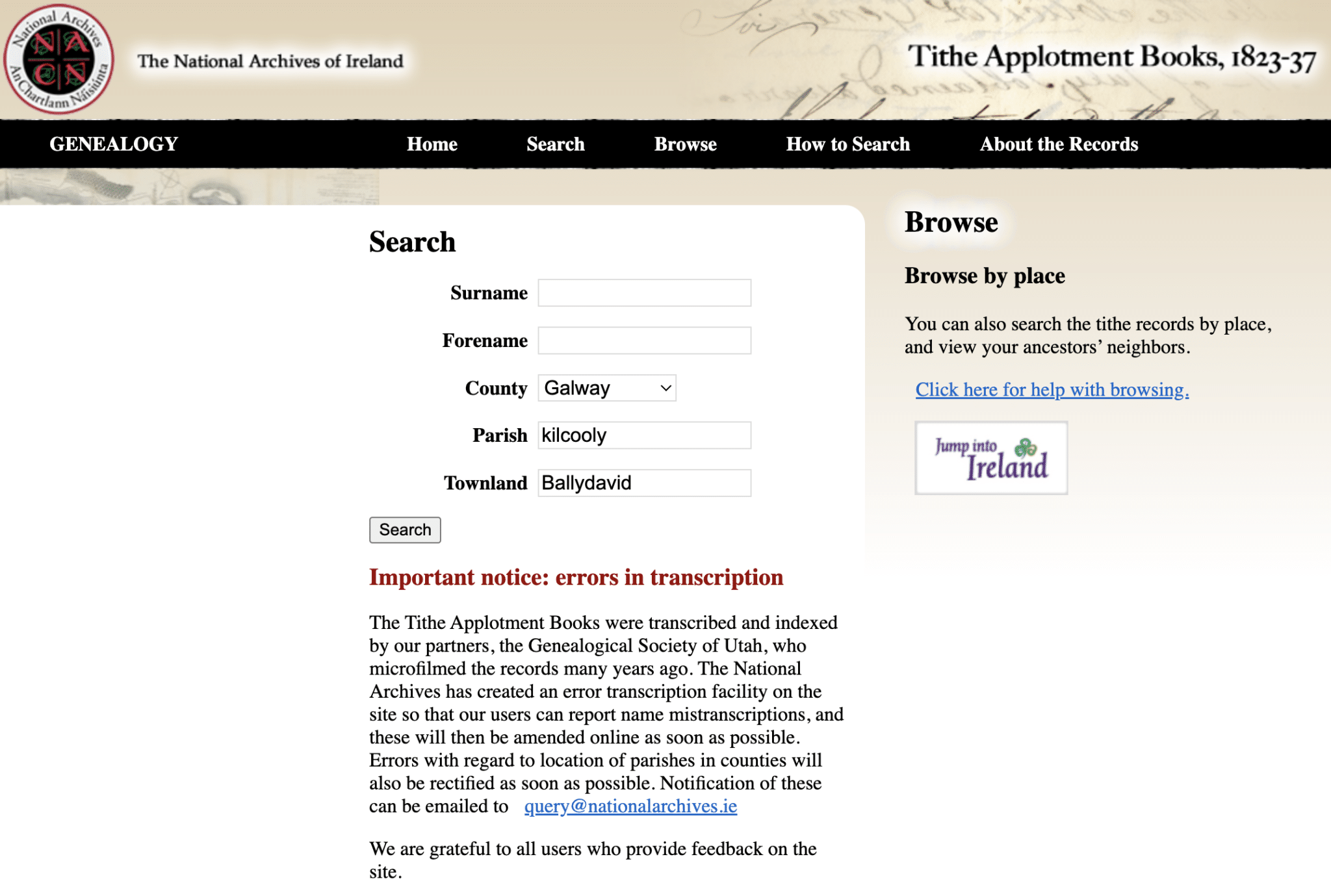
Clicking on the “search” button above, we see the following:
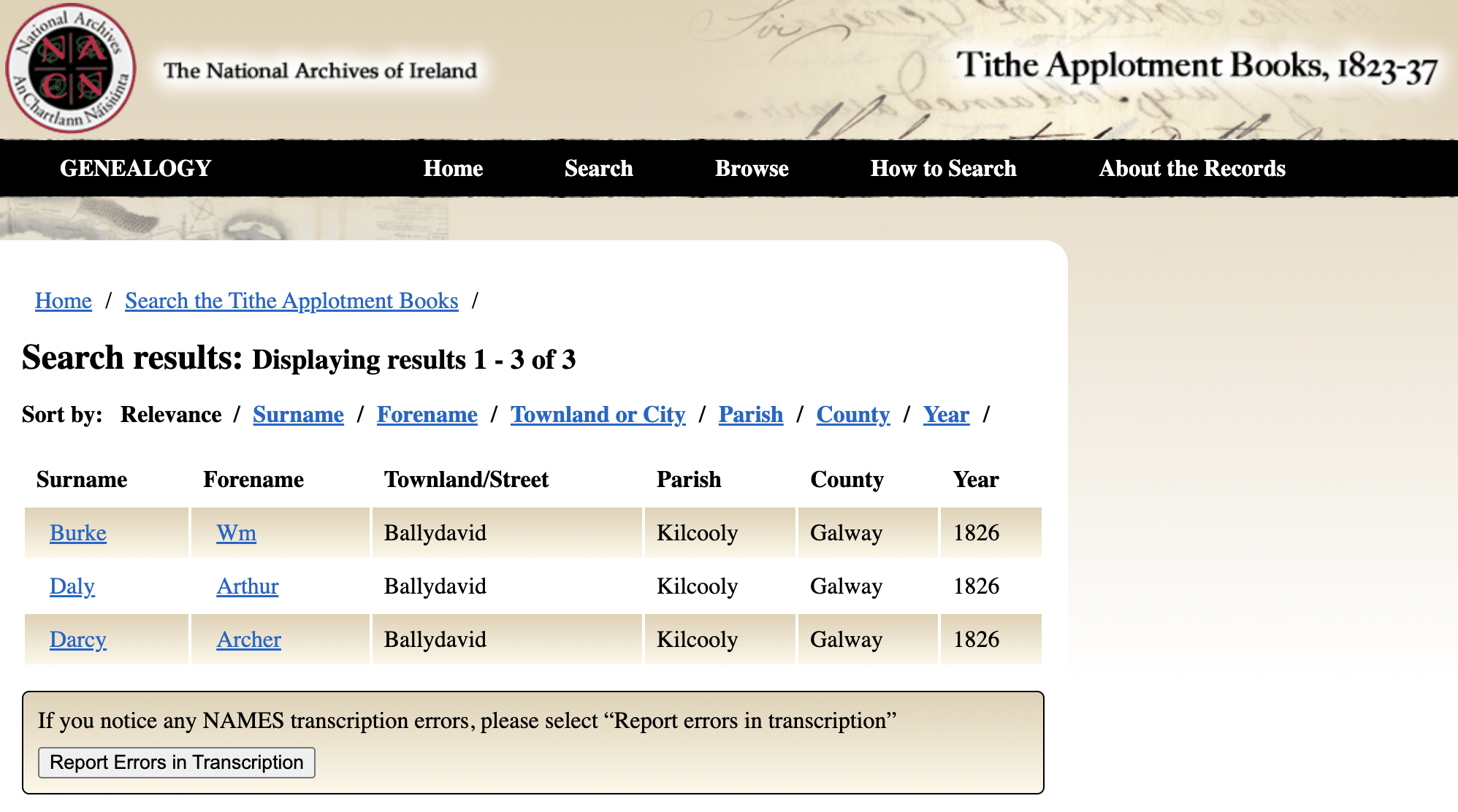
A limited number of families are shown in Ballydavid townland for 1826 – but remember that there may be a number of unrecorded families who owned land below the size assessed for tithes. Click on any of the names in blue above to see the underlying original applotment page as follows (I have outlined the entries for Ballydavid in red):

We can see that townland names, occupier names and associated valuation information are provided. However, there is no accompanying map information to examine like we had with the Griffith’s Valuation.
Now, let’s go back to the Tithes Applotments search page to see if these are any other Dolphin families listed for Kilcooly parish for the time:

When we click on search button above, the following screen appears:
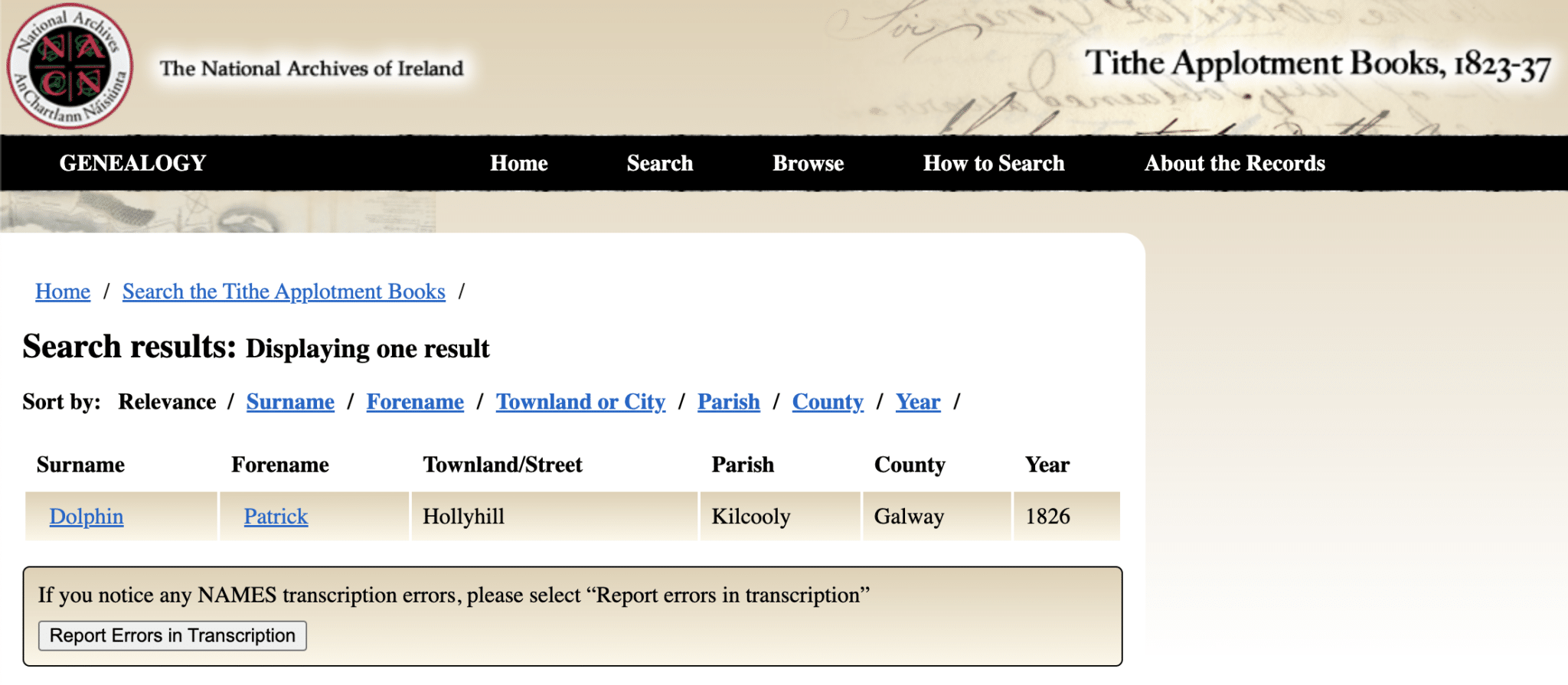
The townland mentioned above is “Hollyhill”. But, where is that in relation to Ballydavid townland?
SIDENOTE: I was considering whether to include this section of the course as it might cause confusion. However, in the interests of transparency and completeness here we go:
From time to time you will find a townland name provided (in this case, “Hollyhill”) that you cannot find in any Irish civil records. This can often be explained as follows. The first ordnance survey mapping of Ireland took place between 1833 and 1846. It was a magnificent achievement for the time – well ahead of similar efforts in many other countries. This mapping initiative provided us with the historical maps we came across earlier in the Griffith’s Valuation part of this module.
Part of the work around the Ordnance Survey of the time was to standardise the placenames used in those maps – including the townlands in each civil parish. These standardised townland names were often an anglicisation of the original Irish names for the townland.
Let’s take a relevant example. There was a townland in Kilcooly parish with an ancient Irish name of “An Cheathrú Rua” and this became anglicised as “Carrowroe” townland as part of the ordnance survey mapping of Kilcooly parish. However, the locals of the time were already referring to this townland as “Hollyhill” – after the main house of the townland (and home of the main landlord) that was built in the late 1700s.
As a result, you will find that the townland of Hollyhill mentioned in the Tithe Applotment Books of 1826 (which were recorded BEFORE the Ordnance survey mapping of the 1830s) is called “Carrowroe” in most later civil records such as Griffith’s Valuation, the civil records and census records. On the other hand, you will often find that “Hollyhill” is used instead of “Carrowroe” in the RC Church records.
This is a situation that you need to be aware of if you ever come across a placename that you think is a townland but you just can find it in the records anywhere. How did I discover that “Hollyhill” and “Carrowroe” townlands were one and the same? A bit of luck, cross-examing maps and talking with the locals! You can also examine a useful resource site called https://www.logainm.ie/en/ – for each townland listed there you will usually see a notes on previous names/spellings for different townlands and placenames.
Now, back to the main course…
This is quite exciting as Hollyhill is a townland that was later named as Carrowroe in the records and located adjacent to Ballydavid townland. Is it possible that we have uncovered the grandfather of the Patrick Dolphin who was born in Ballydavid and died in New Hampshire? That will require more research to figure out.
Click on Patrick Dolphin’s name in the Tithe Applotment Books transcription above and you will see the original Tithe applotment page from 1826 – showing neighbours etc. (this brings us to the same Applotments page as the one we saw earlier for Ballydavid:
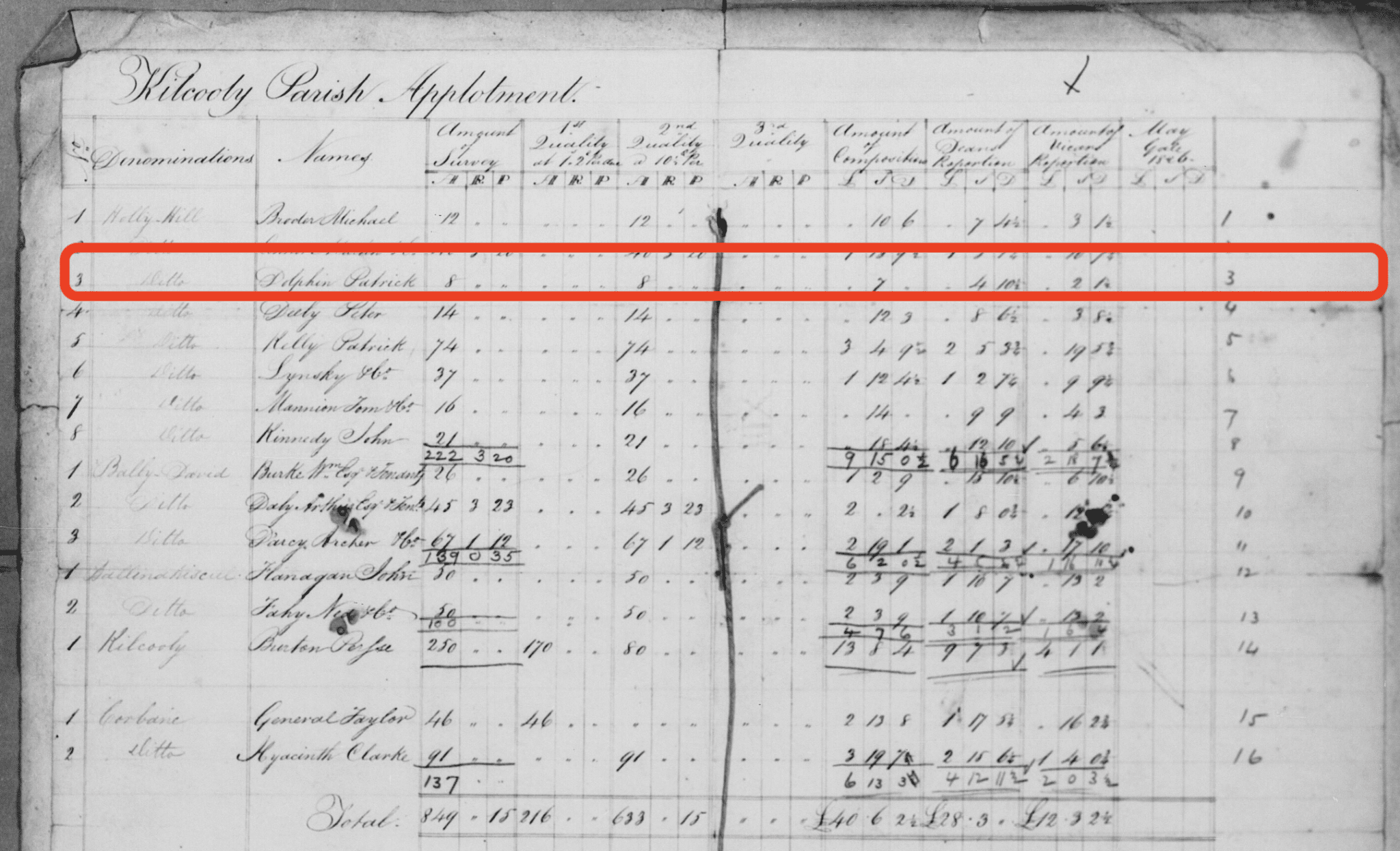
So, that concludes our tour around the two main free Irish land records sets – the Tithe Applotment Books of the 1820s/30s and the Griffith’s Valuation of the 1850s. Let’s now review the information we have discovered and see how that fits in with our earlier discoveries.
Summary of Findings.
Let’s review our findings so far using the “Discovery Questions and Answers Worksheet”. New answers/notes shown below in red. :
| Discovery Question | Answer/Notes |
|---|---|
| Where was Patrick Dolphin born in Galway? | We found an RC baptismal record for a Patrick Dolphin born to Michael Dolphin and Margaret Butler in 1855 in Leitrim parish. This Patrick also had 2 siblings recorded – James (b 1848) and Martin (b 1857). We found no church marriage record for Martin Dolphin and Margaret Butler from sometime before 1848. We found 2 death records for Michael Dolphin (d 1900) and Margaret Dolphin (d 1900) of Ballydavid. Deaths were reported by Martin Dolphin and Hanoria Dolphin of Ballydavid. This information starts to create a strong link between our Patrick Dolphin and Martin Dolphin as brothers and therefore that Patrick’s family lived in Ballydavid and that Patrick was most likely born there. |
| Is Ballydavid in County Galway? | Yes. Ballydavid is in: Civil Parish: Kilcooly SRD: Loughrea RD: Bullaun DED:Kilmeen Near Market Town: Loughrea RC Church Parish: Leitrim and Kilcooly. RC Dioceses: Clonfert. Source: All sources shown in “Land Division Research Worksheet” |
| Was there a Dolphin family living there in 1855? | Yes. We discovered a Michael Dolphin listed in Ballydavid Townland in the Griffith’s Valuation of 1856. We also looked at the location of the house in modern maps and discovered that a number of buildings of the era were probably still standing and the area could possibly be visited for further “on the ground” research. Source: Griffith’s Valuation. Although we did not find a Dolphin family listed in the Tithe Applotment books for Ballydavid townland (1826) – we noted that a “Patt” Dolphin was listed in the adjacent townland of Hollyhill/Carrowroe. This may be worthwhile further researching – is this Patt Dolphin related to Michael Dolphin of Ballydavid in 1856? Source: Tithe Applotment Books. |
| What was Patrick Dolphin’s first wife’s name? | Looks like she was Mary Costillo. Father was Michael Costillo and she was born around 1857. Source: Irish Civil Marriage Record. |
| Where was she from? | Loughrea, County Galway. Source: Irish Civil Marriage Record. |
| When and where did they marry? | Married in the RC chapel of Loughrea, County Galway. January 18, 1881. Source: Irish Civil Marriage Record. |
| Where and when was Michael Dolphin junior born? | Michael Dolphin was born in Loughrea, County Galway on May 3rd, 1881. It looks as if he was born less than four months after his parents marriage. Source: Irish Civil Birth Record. |
| When did Patrick’s first wife die? | We searched the Civil Death records for the period 1881 to 1895 but did not discover any relevant records. |
| Other discoveries: | Found Dolphin family living in Ballydavid in 1901 census – head of family (Martin Dolphin) appears to be the brother of our Patrick Dolphin as they were both living in Ballydavid when married and share the same father’s name. |
Conclusion.
In this module we started searching the Irish Land Records for evidence of a Dolphin family in Ballydavid Townland about 1855 – the probable year of birth for our Patrick Dolphin. We had a number of “discovery questions” in mind to help us focus.
We started by using the Griffith’s Valuation records to see all holdings listed for Ballydavid townland. We found a Michael Dolphin listed there in 1856. Michael Dolphin was the name of the father of our Patrick Dolphin. We also investigated just where Michael Dolphin’s house is likely to be located on a modern map. We discovered that there are probably enough surviving buildings in the area to visit the townland at some point and talk with the current residents for more information.
We then went “back in time” to the Tithe Applotment books of 1826. While we did not discover a Dolphin family listed in Ballydavid townland, we did find a “Patt Dolphin” listed in the adjacent townland of Hollyhill/Ballydavid. Patt Dolphin now goes on to our list of further leads to be investigated.
At this point we have visited all of the most frequently-used online Irish record sets – and the tools to help you to access them in a more effective manner.
The next module – the final one – will aim to tie all of our discovered information together and decide on further steps and research questions to be addresses for our Dolphin family of Ballydavid, County Galway and Manchester, New Hampshire, USA.
Try for Yourself.
I suggest that you:
- Replicate our Griffith’s Valuation findings for the Dolphin family in Ballydavid townland, Kilcooly Civil Parish, County Galway.
- Replicate our Tithe Applotment Book findings for the Dolphin family in Kilcooly Civil Parish, County Galway.
What’s next?
In the next module we wrap up the course by examining all of our discoveries so far – and deciding on next steps and further research questions.

Only Plus Members can comment - Join Now
If you already have an account sign in here.